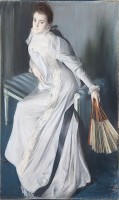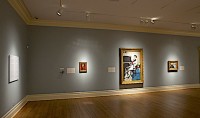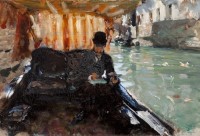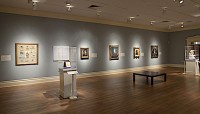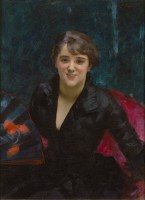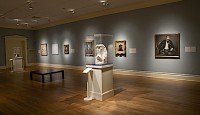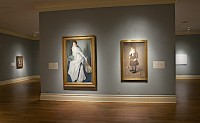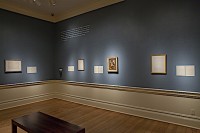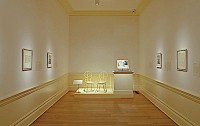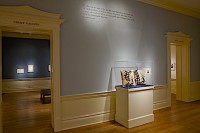The browser will either open the file, download it, or display a dialog.
The Real Beauty: The Artistic World of Eugenia Errázuriz
Dixon Gallery and Gardens, Memphis
January 28–April 8, 2018
Catalogue:
Julie Pierotti,
The Real Beauty: The Artistic World of Eugenia Errázuriz.
Memphis: Dixon Gallery and Gardens, 2018.
128 pp.; 73 color and 21 b&w illus.; checklist; bibliography; index.
$40 (hard cover)
ISBN: 9780997244526
In 2012, the Dixon Gallery and Gardens in Memphis acquired Jacques-Émile Blanche’s exquisite 1890 Portrait of Eugenia Huici Arguedas de Errázuriz in memory of the museum’s former director John E. Buchanan, Jr., shortly after his untimely death at age fifty-eight (fig. 1). Full-length and near life-sized, the pastel portrait is a harmony in gray and blue. Against a gray background, Eugenia Errázuriz (1860–1949)—a Chilean beauty with raven hair, pale skin, and a beaked nose—strikes a serpentine pose upon a gray-and-blue striped chaise, wearing a diaphanous powder blue peignoir and holding a large fan. Created in Paris during the belle époque, the fashionable portrait is an eloquent tribute to Buchanan. His passion for nineteenth- and early twentieth-century French art and decorative fans made an indelible imprint at the Dixon and other art museums where he served as director.[1]
To give context to their impressive new acquisition, the Dixon’s staff immediately began exploring the idea of organizing a monographic show on Jacques-Émile Blanche (1861–1942), a self-taught French artist who worked as a high society portraitist in Paris and London. Blanche remains understudied, even though his works can be found in major museums in England, France, and the United States. Julie Pierotti, the Dixon’s curator, however, persuasively made the case to her colleagues that the portrait’s female sitter, an extraordinary patron and aesthete, would be an even more intriguing subject than its male artist. The exhibition The Real Beauty: The Artistic World of Eugenia Errázuriz and its accompanying catalogue are the fruit of six years of Pierotti’s intensive exploration into Eugenia’s remarkable life, patronage, and artistic friendships.
One of Eugenia’s most notable and enduring friendships was with the American expatriate painter John Singer Sargent (1856–1925), and the title of the exhibition and catalogue is inspired by a passage in the pianist Arthur Rubinstein’s memoirs, in which he recalled Sargent’s high praise for Eugenia:
I have never known anyone with the unfailing, uncanny taste of this woman. Whether in art, music, literature, or interior decoration, she sees, feels, smells, the real value, the real beauty.[2]
Pierotti follows Sargent’s lead as she builds her own vivid account of Eugenia’s refined cultural sensibilities in the exceptionally well-organized exhibition and catalogue. Both are divided into three parts, which correspond roughly with Eugenia’s youth, middle age, and final years.
The first section, which occupies the largest gallery in the exhibition and the longest chapter in the book, spans from Eugenia’s origins in South America to the cusp of the First World War in Europe. On both continents, Eugenia was celebrated for her charm and beauty. In Chile, she was called El sol de Santiago, while in France and England, she was known as La Belle Chilienne. The latter serves as the title for this section, which features many of the portraits for which Eugenia sat in Paris and London.
Eugenia was born in 1860 in Bolivia to Chilean parents of Basque descent. Her father had made a fortune in silver mining. After being educated by Catholic nuns in Chile, eighteen-year-old Eugenia married the aspiring painter José Tomás Errázuriz (1856–1927), the eldest son of a copper mining baron, in 1879. They soon had two daughters, one of whom died shortly after birth, and then the small family left Chile for Europe in 1882. The Errázurizes had their two other children—a son and a third daughter—in France. Eugenia would remain in Europe for more than sixty years and José Tomás would die there forty-five years later, returning home to Chile only once for a brief visit.
From 1882 to 1900, the Errázurizes resided in Paris, where José Tomás’s younger sister, Amalia Errázuriz de Subercaseaux (1860–1930), and her husband, Ramón Subercaseaux Vicuña (1854–1937), a diplomat who represented Chilean mining interests in Europe, had lived between 1880 and 1881. Amalia and Ramón are key figures in Pierotti’s story because they gave Eugenia and José Tomás entrée into the upper echelons of Paris’s art world, starting with an introduction to Sargent.
The exhibition opens with Sargent’s enchanting formal portrait of Amalia Subercaseaux seated at the piano in her and her husband’s elegant Paris apartment. Still in a private collection, the luminous flower-filled composition shines in its temporary home at the Dixon, which is surrounded by magnificent gardens. Close in age to Sargent, the Subercaseauxes formed a fast friendship with the artist during the hours he spent in their home capturing Amalia’s likeness. In the summer of 1880, the couple rendezvoused with Sargent in Venice and, like him, stayed in Ca’Rezzonico on the Grand Canal. Sargent and Ramón, who was an amateur painter, proceeded to spend much time together studying the Venetian masters and painting en plein air in the lagoon city’s unique conditions. In the exhibition, Sargent’s Mme Ramón Subercaseaux is flanked by two far less formal portraits that Sargent made of Ramón in Venice (fig. 2). On one side is a rapid oil study of the handsome diplomat, while on the other is the Dixon’s own little gem, Ramón Subercaseaux in a Gondola, which Sargent playfully painted while he and Ramón bobbed up and down together on the water (fig. 3). Nearby, Venetian watercolors by Ramón are displayed.
Two years later, when Eugenia and José Tomás arrived in Paris, they, too, began patronizing Sargent, buying two of his magical oil paintings set in Capri. Sargent painted his first portrait of Eugenia around this time—a bust-length oil sketch signed “Souvenir de John S. Sargent,” which suggests he gave it to the couple as a gift and a token of their new friendship. This painting, while not in the show, is discussed and given a full-page color illustration in the catalogue. Sargent’s three other portraits of Eugenia executed in the early 1880s are all on view, hung together on a wall that introduces exhibition visitors to Eugenia’s vivaciousness and warmth (fig. 4). The largest and most dynamic of these—an oil portrait sometimes called The Lady in Black—shows Eugenia wearing an unadorned black dress, holding a painted fan, and rising from her chair to greet us (fig. 5). The preparatory oil study nearby illuminates Sargent’s portrait painting process.
In the catalogue, Pierotti argues that the spare aesthetic for which Eugenia would later be celebrated is already evident in these early portraits of her by Sargent. It is true that, compared to Sargent’s other portraits of women, such as Mme Ramón Subercaseaux, his depictions of Eugenia are strikingly simple and must reflect her taste.
In 1887, the Subercaseauxes joined the Errázurizes in Paris. By then, Sargent had moved to London, and the two Chilean couples now focused their patronage on other artists in the French capital, including the Italian portrait painter Giovanni Boldini (1842–1931) and the French sculptor Auguste Rodin (1840–1917). The exhibition includes Rodin’s marble Galatée, which Eugenia purchased in 1888. The female nude emerging from an unfinished stone block has an especially powerful presence in a gallery otherwise dominated by portraits (fig. 6).
In 1889, the Errázurizes commissioned Jacques-Émile Blanche to create two pastel portraits, the one of Eugenia recently acquired by the Dixon and one of their young son Maximiano (1885–1942) (see fig. 1). The works were made in the artist’s studio in 1890. In the exhibition, these two portraits occupy center stage. They hang together on a freestanding wall in the middle of the grand opening gallery (fig. 7). As Pierotti highlights in her detailed discussion of the works in the catalogue, Eugenia’s attire in her portrait was austere for a socialite. Her hair pulled back, she wears a dressing gown and no jewelry. The fan she holds is plain. Nonetheless, the picture is still luxurious, with its delicate colors and Blanche’s masterful rendering of the long, translucent gown. Clearly, Eugenia is a woman of wealth and leisure. Two of her fingers rest on her midsection and Pierotti explains that Eugenia was likely pregnant with her last child, a girl named Maria born later that year. Blanche’s portrait of Maximiano, who was only three or four years old at the time, also emphasizes family. The artist presents the Errázurizes’s only male offspring as a royal prince by drawing on traditions of Spanish court portraiture. This pastel now belongs to the Art Gallery of Hamilton, Ontario, and this exhibition provides a rare occasion to see Blanche’s two intimately related works for the Errázurizes together.
A decade after Blanche painted these two portraits, the Errázurizes left Paris for London, where they settled near Sargent in Chelsea and were able to resume their close friendship with him. The exhibition and catalogue include Sargent’s 1905 portrait of Eugenia in charcoal, his preferred medium for commissioned portraits at that time. Aging before our eyes, Eugenia is fifteen years older here than in Blanche’s pastel portrait of her. She is now more matronly and crowned with a large hat—a kind of accessory that she often wore in portraits made during this stage in her life.
By 1908, Jose Tomás’s health started declining; to recuperate, he spent long periods of time in Switzerland, while Eugenia and their grown children remained in London. In the years that followed, the couple unofficially separated, but never did divorce. Eugenia’s nephew, José Antonio (“Tony”) Gandarillas, who also liked to surround himself with artists, and his wife Juanita welcomed Eugenia into their London home on Tite Street, the very street where Sargent lived and kept his studio. A fixture at parties, Eugenia socialized with many other artists and expatriate friends in London, too.
The second section of The Real Beauty spans from the beginning of the First World War to the end of the Second World War, when Eugenia chose to spend most of her time in France and carved out an almost completely new identity and independent life for herself. Letters reveal that she and Jose Tomás had argued about money when they were together; without him by her side, she was free to spend more lavishly, and did.
Through her friendship with Blanche, Eugenia met the French writer Jean Cocteau, who, in turn, introduced her to the one of the greatest artists of the twentieth century, Pablo Picasso (1881–1973). They met in 1916. Eugenia, who, at fifty-five, was twenty years older than Picasso, became a mother figure to the bohemian Spanish artist and one of his staunchest advocates. She referred to herself as Picasso’s vieja admiradora (old admirer), which Pierotti uses as the title of the exhibition’s second section and the catalogue’s second chapter. Eugenia furnished Picasso with a monthly stipend and lavished him with presents, becoming a far more involved and invested art patron than ever before.
Eugenia acquired three major paintings by Picasso soon after befriending him. The first was Portrait of a Young Girl, which portrays Eva Gouel, the artist’s lover. The Cubist painting was radically different from the portraits already in Eugenia’s collection by painters such as Sargent and Blanche. Next, she acquired Picasso’s Man with a Pipe, another synthetic Cubist masterwork. Grateful for her support, Picasso proclaimed his desire for Eugenia to have his Man Leaning on a Table; it is unclear whether she bought it or he gave it to her as a gift. In 1925, she acquired a fourth painting by the artist, the still life Compotier, Bouteille, Guitare.
These four paintings were among Eugenia’s most prized possessions and during the Second World War she hid them behind a curtain to keep the Nazis from finding them. Now scattered in four different collections in Europe and America, none of them was able to travel to Memphis to be part of the exhibition, and far more modest works, mainly simple line drawings and photographs, shown in a small gallery, stand in for them and this significant phase in Eugenia’s life and Picasso’s career (fig. 8). Pierotti’s well-written and illustrated chapter in the catalogue, therefore, is particularly important for this section.
Eugenia opened many doors for Picasso, including the one that would ultimately lead him to his first wife, the ballet dancer Olga Khokhlova. Eugenia introduced Picasso to Sergei Diaghilev, founder of the Ballets Russes, who engaged the artist to design costumes for Parade. While working on the ballet in Rome, Picasso fell in love with Olga, a Russian dancer in the group, and she with him.
In early 1918, as the war made Paris a much less desirable place to live, Eugenia found a cottage to rent in Biarritz, a French resort town near the Spanish border. She called the house La Mimoseraie because of the abundance of mimosas in its large garden, and a few years later arranged to buy it. The stucco home became famous as the honeymoon destination for Picasso and Olga. In addition to giving them the entire second floor (which Picasso frescoed), Eugenia set up a studio for Picasso there, and the newlyweds stayed for two months in the summer of 1918. The exhibition includes a Cubist painting, Abstraction, Biarritz, made by Picasso at La Mimoseraie during this period. While in Biarritz, Eugenia also introduced Picasso to the art dealers Nathan Wildenstein and Paul Rosenberg, who would soon represent the artist in both Europe and the United States. Thus, in a myriad of ways, ranging from love to money, Eugenia made herself an indispensable part of Picasso’s life in these years.
The third and final section of the exhibition and book is “The Queen of Good Taste,” which explores Eugenia’s influential decorating ethos. Especially after she and her husband separated and her children grew up, she refined her interior design aesthetic, which can be summed up as clean and sparse. “No bibelots (trinkets)” was one of her mantras (81). Another was “elegance means elimination” (82). To fashion photographer Cecil Beaton (1904–1980), La Mimoseraie was “decorated like a peasant’s house,” which was precisely the look she sought (82). In her later years, Eugenia deepened her commitment to simplicity by becoming a Franciscan tertiary, albeit one dressed in a black chemise said to have been designed by Coco Channel (1883–1971).
The modernist French decorator Jean-Michel Frank (1895–1941), who was related to the diarist Anne Frank, became Eugenia’s interior design disciple. He fell in love with her combination of clean lines and sumptuous materials and used her principles to launch a successful career. Through her, he found clients in Paris, Santiago (where he fled to escape the Nazi occupation of Paris in 1940), and New York. Sadly, he committed suicide while still in his 40s during a stay in Manhattan.
The Dixon secured a fascinating array of objects to tell the story of Eugenia’s friendship with Frank. In a long rectangular gallery, visitors encounter a pair of wrought iron chairs designed by him and the Swiss sculptor Alberto Giacometti (1901–66) in 1935 (fig. 9). The spindly chairs directly quote ones owned by Eugenia. Nearby is displayed an article written by Frank for Harper’s Bazaar in February 1938, which features photographs of Eugenia’s Paris apartment. The images show how Picasso’s Cubist paintings appeared in the stark interiors she created. Eugenia made needlepoints after Picasso’s drawings and paintings, examples of which can also be seen in the magazine. Two of those needlepoints, now covering pillows, are also part of the exhibition (fig. 10).
In the early 1940s, Eugenia’s situation changed dramatically, as her financial resources finally dried up. In desperate need of money, she began selling off her artworks one by one, including all her valuable Picassos. Her three children moved to Chile during the Second World War and they arranged for her to join them in Santiago in 1948. Eugenia died there, far from the artist friends and creations by them that had filled her life with joy, at the age of eighty-nine. Her collection is now dispersed onto at least three continents and into many different collections, both public and private, and it is amazing that the Dixon’s staff was able to reassemble as much of it as they did in Memphis.
Throughout this exhibition, the design is restrained, with muted wall colors and elegant, minimal graphic design elements. Undoubtedly, Eugenia would have been pleased. It is also admirable how well the works are hung. They are logically organized and spaced in such a way that the greatest artists in the exhibition—Sargent and Picasso—do not eclipse lesser talents. A map and family tree help visitors understand the complicated story being told. Text panels are in Spanish as well as English.
The catalogue, too, is refined. Pierotti’s text is written with panache and never slips into gossip, the way some earlier accounts of Eugenia’s life do. The footnotes, bibliography, and index make the catalogue a useful tool for other researchers interested in Eugenia and the various artists she patronized. Because an acquisition inspired the exhibition, the catalogue will long remain a reference for all future visitors to the Dixon.
Until now, Eugenia and other members of her South American circle have been almost entirely unknown in the English-speaking world, except to cognoscenti, such as the great Sargent scholar Richard Ormond, Picasso’s eminent biographer Sir John Richardson, and the design historian Mo Teitelbaum. They had each only looked at part of Eugenia’s life, however; and it is to Pierotti’s credit that she saw the value of examining it in its entirety, because only then does Eugenia emerge as a subject who defies our expectations.
To be sure, this exhibition and its catalogue make a vital contribution to our understanding of the dynamics of patronage in London and Paris in the late nineteenth and early twentieth centuries. The tight focus of The Real Beauty left no real opportunity to mention how Eugenia compares to other female patrons of the period, such as Claribel and Etta Cone, Isabella Stewart Gardner, and Gertrude Stein, but Pierotti lays the groundwork for that kind of analysis.
The Dixon Gallery and Gardens is a small museum with a small staff. They invested significant time, energy, and resources into this incredibly intricate project and it shows. The Real Beauty required extensive planning, diplomacy, research, coordination of loans from many lenders, and more. I applaud the museum for this impressive feat and look forward to seeing what wonderous exhibition Pierotti and her colleagues will dream up next.
Trinita Kennedy
Curator, Frist Art Museum
tkennedy[at]FristArtMuseum.org
[1] John Buchanan wrote his graduate thesis at Vanderbilt University on Japonisme. He served as the director of the Dixon Gallery and Gardens from 1986 to 1994, the Portland Art Museum from 1994 to 2005, and the Fine Arts Museums of San Francisco from 2005 until his death in December 2011. For his exhibitions and acquisitions of French art at these museums, see Kevin Sharp, “The Phenomenon of John Buchanan,” in Robert Flynn Johnson and Richard R. Brettell, Henri Guérard and the Phenomenon of the Artist’s Fan in France, 1875–1900, exh. cat. (Memphis: Dixon Gallery and Gardens, 2016), xv–xx. Buchanan and his wife Lucy gifted their collection of artist-painted fans to the Dixon. The Blanche portrait was acquired for the Dixon with donations from more than thirty of his friends and museum supporters over twenty years after he left the museum.
[2] Arthur Rubinstein, My Young Years (New York: Alfred A. Knopf, 1973), 446.


